Seating Protocols in Japan for Business Meetings and Dinners
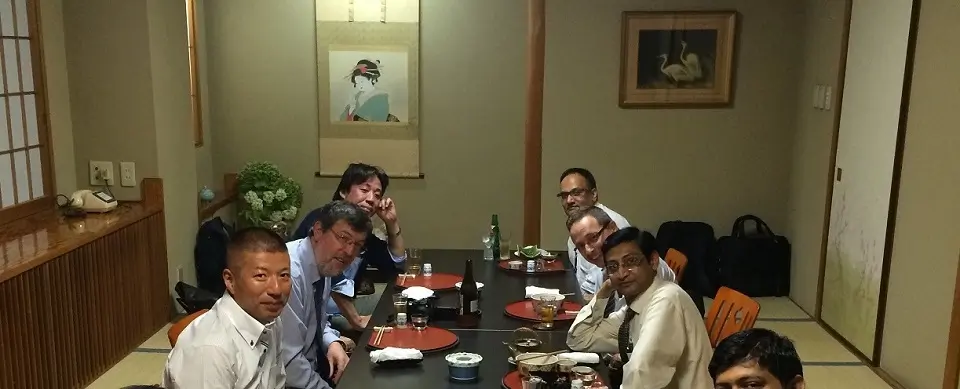
There are many unspoken rules of etiquette in Japanese business, and Japanese seating protocols are no exception. The importance Japanese people give to formal seating arrangements is evident from the fact that there is a Japanese word for it: It is (Sekiji 席次).
The seating protocols in Japan reflect the cultural tradition of hierarchy, status, and rank prevalent in Japanese society, especially in business.
As a matter of fact, in certain situations, the seating protocols in Japanese business meetings can be confusing for the Japanese as well. However, protocols for formal seating arrangements in Japan are crucial from a cultural perspective. Getting them wrong can be viewed as a sign of disrespect. T
History of Seating Protocols in Japan
Japanese seating protocols date back to the feudal period or the age of the Samurai in Japan.
In those times, the Shogun, the supreme leader of Japan, always sat in the highest seat of honor. This seat of honor is called Kamiza (上座) seat. The Kamiza seats are far from the room’s entrance, in an area slightly elevated from the rest.
The Kamiza seat for the senior-most people is in front of an area called Tokonoma (床の間). Tokoma or Toko space is adorned with a calligraphy scroll, paintings, and traditional flowers.
All junior ranking members used to sit in the lower seats, called Shimoza (下座), in descending order.
The lowest rank used to sit near the entrance. This was to protect the Shogun from any possible attack from outside.
The same tradition of seating arrangements continues today for business meetings in Japan.
Principles Behind Japan’s Formal Seating Arrangement
The seating protocols in Japan differ from those in Western and many other countries. In Western culture, seating arrangements often revolve around power dynamics, with senior members occupying the central positions and junior members arranged in descending order on either side. However, Japan’s business meeting seating protocols prioritize convenience rather than power.
In Japanese meetings, senior individuals are seated in positions that offer the least convenience. These seats strategically minimize any disruptions caused by the movement of junior participants during the discussion.
The seats with the highest level of convenience are always positioned as far away from the door as possible, resulting in senior members naturally occupying the seats farthest from the entrance.
Additionally, when hosting business partners, Japanese customs dictate that guests are seated on the side of the table opposite the door as a sign of respect, indicating that hosts are not looking for guests’ departure.
Where should People Sit in Japanese Business Meetings?
Seating arrangements during Japanese meetings may vary depending on whether they are internal office meetings or meetings with external business partners.
However, the protocols for the seating arrangements are stricter during meetings with external business guests. People are more relaxed about seating arrangements during internal meetings unless some very senior officials are present.
While this article will discuss all the details of the formal seating arrangements in Japan, it is quite simple and is as follows:
“The business guests sit on the opposite side of the door, with the most senior person sitting furthest away from the door. After that, the remaining guests sit in descending order of seniority. The team from the hosts sit at the door side of the room, with the senior-most person with a seat furthest away from the door“.
Let’s have a look at the protocols for the internal vs. external business meetings to see the right way to sit:
Seating Arrangements During Internal Japanese Office Meetings
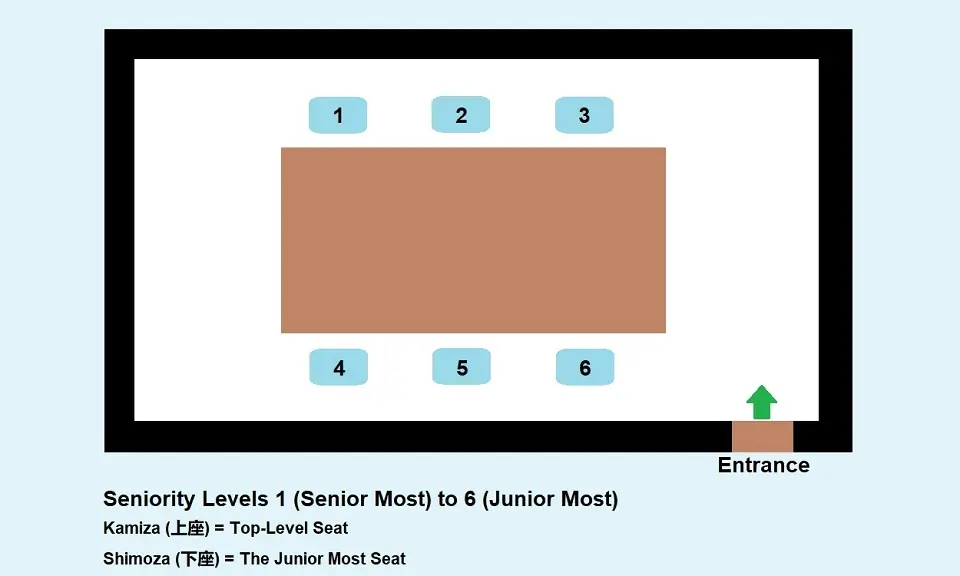
Nowadays, formal meetings take place in Western-style conference rooms in Japanese offices. However, the same principles apply to the seating arrangements.
While waiting to enter the meeting room, members usually stand outside the door with the senior-most person in front.
After entering the room, the senior-most person will sit furthest from the door at the head of the table, followed by the junior members in descending order.
The junior-most person will sit nearest to the door. The reason is if there are any requests from senior staff, such as bringing additional documents, beverages, etc., then the junior most will be the one to leave the room to meet the requests.
However, during internal business meetings, the senior ranking member may decide the seating arrangements, depending on specific needs.
Seating Protocols During Client Meetings in Japan
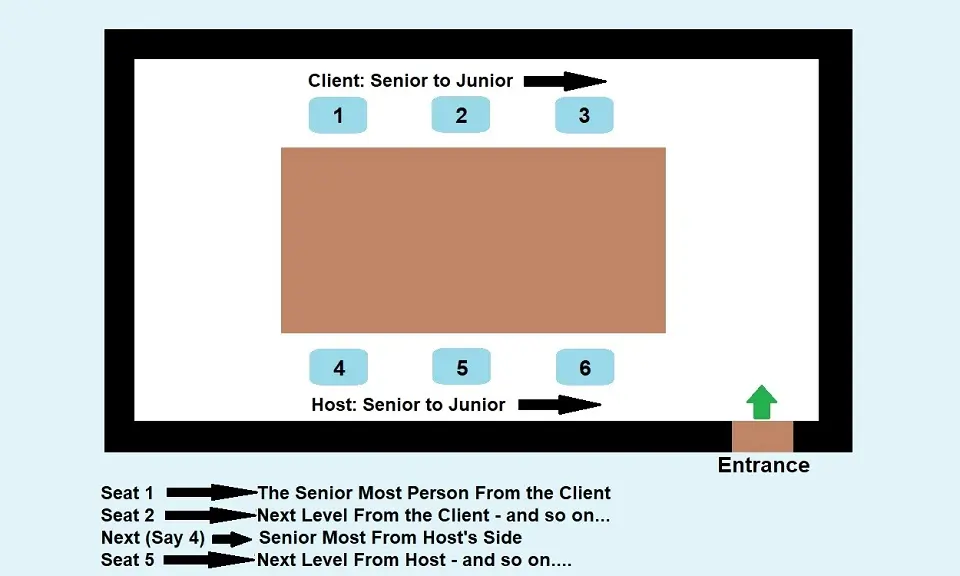
Seating protocols become very important during Japanese business meetings if both parties are Japanese. However, if you are an expat who has been living in Japan for a considerable time, people will expect you to follow the protocols.
These are Japanese unspoken rules, and you should get them right to avoid making a negative impression that you do not know Japanese customs. Not following the protocols may make someone likely to lose face and not earn the proper trust for a long-term business relationship.
In meetings of foreigners with Japanese, it is still necessary to follow these seating arrangements. However, the risk factor is lower, depending on how accustomed they are to traditional Japanese practices.
In fact, foreigners who have lived in Japan for a long time sometimes follow these customs better than many young Japanese.
So, whether you are a Japanese or a foreigner, it is still paramount to follow the tradition of sitting arrangements regardless of the situation.
The Customer is the Guest of Honor
In meetings, the customer is the guest of honor and will take the room’s best or most comfortable seat.
The seat furthest from the door prevents discomfort if a junior person needs to go out for any requested tasks.
If there is more than one person from the client’s side, the senior most will sit furthest from the door.
Upon entering the office building, the visitors wait in the reception area till the hosts lead them to the meeting room. The hosts will wait in the lower (Shimoza) seats, with the most senior members sitting farthest from the door and the most junior closest to the door.
When the guests enter the meeting room, the hosts should stand, as sitting at such a time is considered rude.
If the hosts and the guests are both outside the room, then after the greetings, it would be polite to ask the guests to enter first. The most senior member of the guests is offered the best seat or Kamiza, which is the farthest away from the door. This is followed by the next senior, and so on.
Then, the most senior from the host group would sit opposite the senior guest in the Shimoza seat. And the most junior host group member sat near the door. At times, the senior-most persons from both sides may also sit at the center of the table, facing each other. However, even in that case, the junior most person would sit closest to the door.
Seating Protocols at Japanese Business Dinners
Regarding seating etiquette during business dinners, the same guidelines apply.
The guests should be seated in the most comfortable seats. For example, in a private room (either Western or traditional tatami), the senior-most from both parties would sit in the Kamiza seats, which are furthest from the entrance to the room. And the junior would sit near the door in the Shimoza seats, with the junior-most nearest to the door.
The rules may be less rigid if the meeting is not in the office but in a public open space like a restaurant. However, senior members will sit facing each other. Following are the practical reasons that make sense for this tradition in this setting:
- After exchanging any gifts, junior members carry those gifts and place them near the room entrance.
- Junior members of the host’s side can immediately action any requests from senior members of the hosts or any members of the customers.
- After dinner, juniors leave the room first to pay the check, call for the car or taxi, etc.
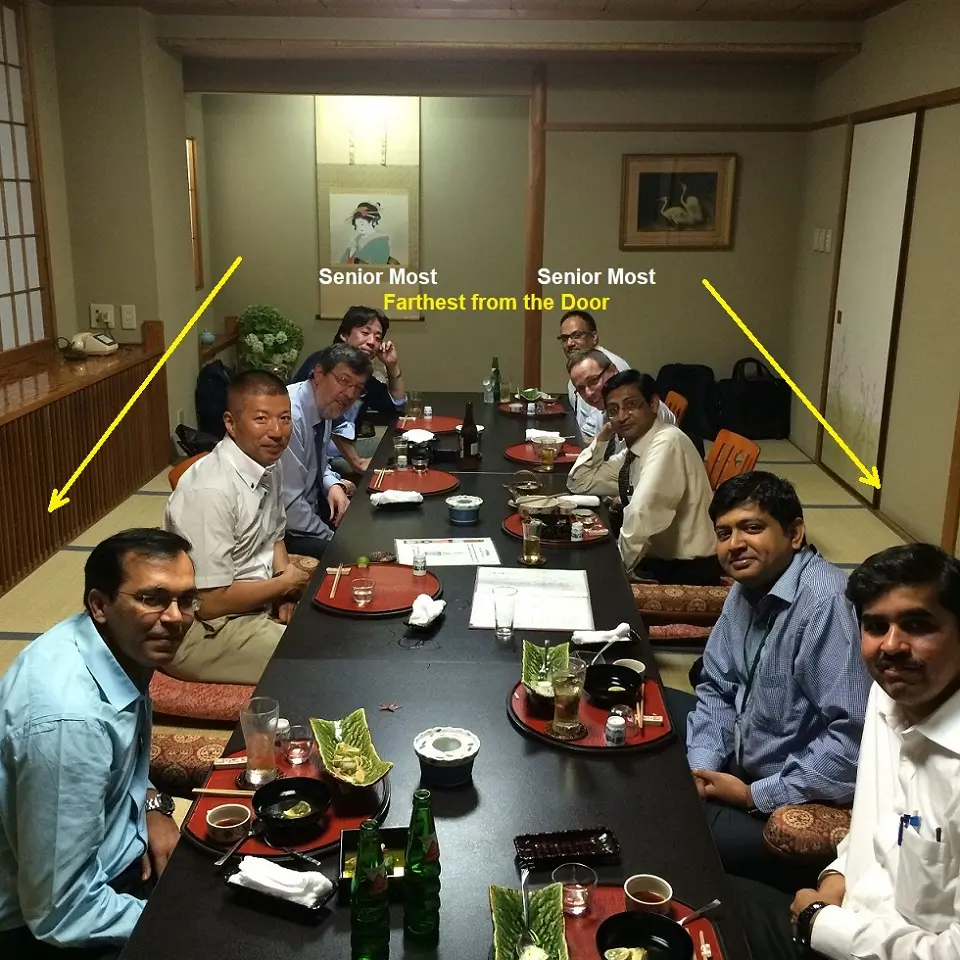
Note: The above picture is of an actual business dinner to illustrate the seating arrangement during a Japanese business dinner. In this picture, the left-side seating area for the client is opposite the entrance, and the right side is towards the door. The hosts are on the right side.
On the right-hand side of the table, the seniority of the first two persons cannot be compared as one was from the client side. Similarly, on the left-hand side, there is a combination of the client-side team and the hosts. Such mix-ups are common when the settings are not 100% traditional Japanese.
We wish to thank everyone for their permission to publish this picture of this business dinner.
Do These Seating Arrangements Apply to All Companies in Japan?
These seating protocols are the standard norms in Japan, regardless of whether you work for a Japanese or multinational company.
Even though a company in Japan may be global with foreign headquarters, its employees are still nearly all Japanese. The same is true of its clients, as most of them are Japanese.
However, it may seem over the top for foreigners unfamiliar with this tradition. And yes, some do ask if this is not demeaning!
However, it is not because formal seating arrangement protocols are followed in all business settings in all countries. The only difference is that in Japan, it’s done consciously as a set process, while in many other countries, people may do it subconsciously.
Consider a setting in a Western or any other country. Imagine a case where the most senior leader is sitting near the door. It would suggest that the leader is the last one to come. Would that be a sign of leadership?
Next, picture a business meeting with a rectangular table, with senior members sitting in the middle and juniors surrounding them on either side! This would suggest a battle-like situation or confrontation where other team members protect people senior to them. Not only that but consider the lack of efficiency in making way for each other while everyone is trying to sit.
The above two examples make it clear that formal seating arrangements are not just part of Japanese culture but are entirely logical.
Conclusion
The protocols for seating arrangement have deep roots in Japanese culture and tradition and exemplify the importance of hierarchy, status, and rank to maintain order and harmony. Furthermore, it reflects the Japanese ideals of showing reverence and respect. And that’s not only for elders but for guests, and it remains an integral part of Japanese culture!
Therefore, it is very important to be sensitive about the seating protocols even when you are in the company of not-so-traditional Japanese people. It is always better to be safe than sorry.
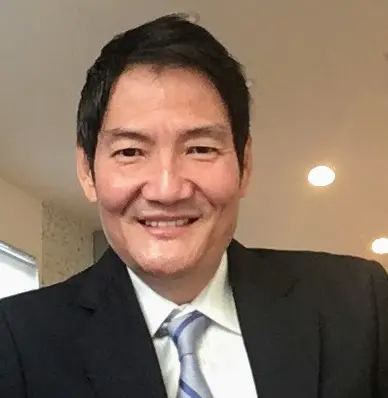
Native Japanese raised in the USA, Yoshinobu Takaoka returned to Japan 20 years back and is a senior finance professional with over 20 years of working experience in Japan. While being Japanese, Yoshinobu has a deep understanding of Japan and Japanese customs, growing up in the U.S. he also has a deep understanding of western culture and what makes foreigners curious about Japan.
